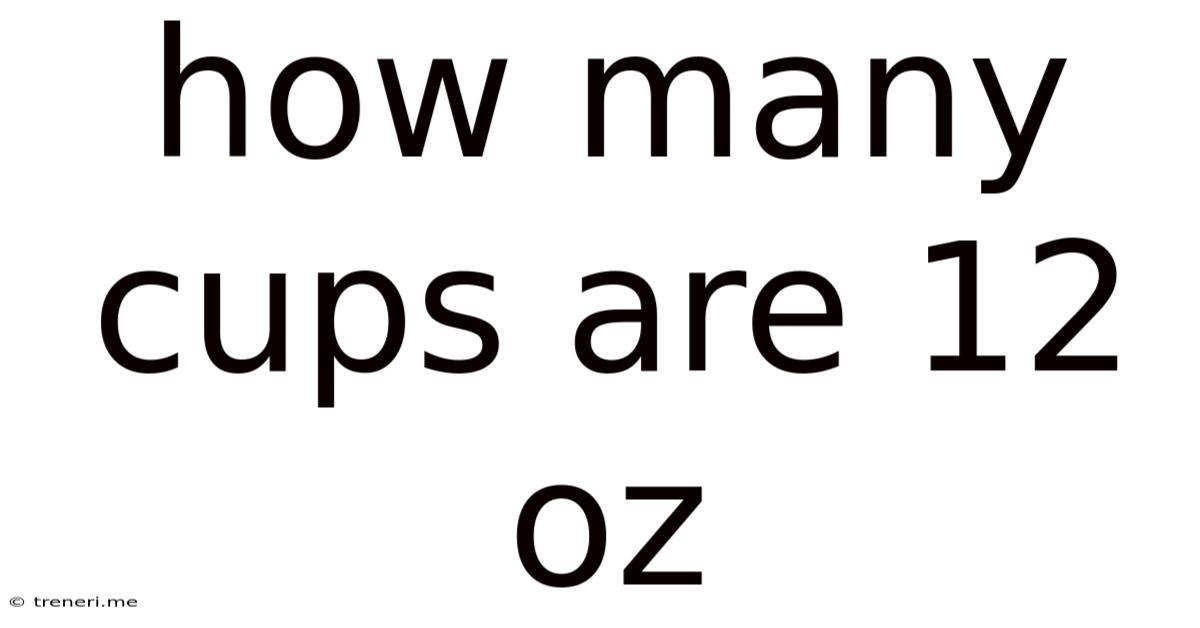How Many Cups Are 12 Oz
Treneri
May 13, 2025 · 4 min read

Table of Contents
How Many Cups Are 12 Oz? A Comprehensive Guide to Volume Conversions
Understanding volume conversions, particularly between ounces and cups, is crucial in various aspects of life, from cooking and baking to crafting and even scientific experiments. A frequently asked question is: "How many cups are 12 oz?" This seemingly simple query leads to a deeper exploration of measurement systems and the nuances of volume conversion. This comprehensive guide aims to answer this question definitively, provide context for different scenarios, and equip you with the knowledge to confidently navigate future volume conversions.
Understanding Ounces and Cups
Before diving into the conversion, let's establish a clear understanding of the units involved: ounces (oz) and cups (c). These units are commonly used in the United States customary system of measurement.
Ounces (oz): An ounce is a unit of weight or mass, but in the context of volume, it usually refers to fluid ounces (fl oz). A fluid ounce measures the volume of a liquid.
Cups (c): A cup is a unit of volume, commonly used in cooking and baking recipes. The size of a cup can vary slightly depending on the measuring cup used, but the standard US cup is defined as 8 fluid ounces (fl oz).
The Conversion: 12 Ounces to Cups
The core question is: How many cups are in 12 ounces?
The answer is straightforward: 12 fluid ounces is equal to 1.5 cups.
This is calculated by dividing the number of fluid ounces (12) by the number of fluid ounces in a cup (8): 12 fl oz / 8 fl oz/cup = 1.5 cups.
However, the simplicity of this calculation belies the importance of understanding the context in which this conversion is applied.
Context Matters: Variations and Considerations
While the mathematical conversion is straightforward, practical applications often require considering additional factors:
1. Liquid vs. Dry Ingredients
The conversion from ounces to cups holds true for liquids. However, when dealing with dry ingredients like flour, sugar, or rice, the conversion is less precise. Dry ingredients can be packed differently, resulting in variations in volume for the same weight. A cup of flour measured loosely will have a different volume than a cup of tightly packed flour. This is why recipes often specify measurements by weight (grams or ounces) for dry ingredients to ensure accuracy and consistency.
2. Type of Measuring Cup
Measuring cups come in various sizes and designs. While the standard US cup is 8 fluid ounces, variations exist. It’s crucial to use a standardized measuring cup to ensure accuracy.
3. Ingredient Density
The density of an ingredient impacts its volume. For instance, 12 ounces of water will occupy a different volume than 12 ounces of honey because honey is denser. Therefore, the 1.5 cup conversion is most accurate for liquids with similar density to water.
4. Precision and Rounding
Depending on the context, you might need to round the result to a whole number or a fraction. For cooking, rounding to the nearest half-cup (1.5 cups) is often sufficient. However, scientific applications might require more precise measurements.
Practical Applications: Real-World Examples
Understanding the conversion of 12 ounces to 1.5 cups is vital in many everyday situations:
-
Cooking and Baking: Many recipes use both ounces and cups as units of measurement. Knowing how to convert helps ensure accurate ingredient proportions. For example, if a recipe calls for 12 ounces of milk, you'll know to use 1.5 cups.
-
Crafting: When working with resin, paints, or other crafting materials, precise volume measurements are often essential. The ability to convert between ounces and cups ensures consistent results.
-
Medication: Some liquid medications are measured in ounces. Understanding the cup equivalent can be helpful for administering the correct dosage. Always consult a healthcare professional for medication dosage instructions.
-
Scientific Experiments: In experiments involving liquids, converting between ounces and cups is a common requirement to ensure accuracy and reproducibility of results.
Beyond 12 Ounces: Mastering Volume Conversions
While this article focuses on 12 ounces, understanding the fundamental conversion ratio allows you to easily convert other volumes. Remember that 1 cup equals 8 fluid ounces. To convert ounces to cups, simply divide the number of ounces by 8. To convert cups to ounces, multiply the number of cups by 8.
Here are some example conversions:
- 16 ounces: 16 oz / 8 oz/cup = 2 cups
- 24 ounces: 24 oz / 8 oz/cup = 3 cups
- 4 ounces: 4 oz / 8 oz/cup = 0.5 cups (or ½ cup)
Conclusion: Accurate Measurements for Success
The question "How many cups are 12 oz?" leads to a deeper understanding of volume measurement. The answer, 1.5 cups, is simple mathematically, but contextually rich. Whether you're cooking, crafting, conducting experiments, or navigating everyday life, understanding volume conversions ensures accuracy and consistency, leading to better outcomes in numerous applications. Remember to consider the type of ingredient, measuring tools, and the required level of precision to ensure your conversions are accurate and applicable to your specific task. Mastering these conversions empowers you to confidently tackle any volume-related measurement challenge.
Latest Posts
Latest Posts
-
What Is The Greatest Common Factor Of 15 And 9
May 13, 2025
-
Cuantos Dias Faltan Para El 4 De Julio
May 13, 2025
-
Calculate The Percent Composition Of The Following Compounds
May 13, 2025
-
How Many Ounces In 3 5 Pounds
May 13, 2025
-
What Is The Greatest Common Factor Of 45 And 81
May 13, 2025
Related Post
Thank you for visiting our website which covers about How Many Cups Are 12 Oz . We hope the information provided has been useful to you. Feel free to contact us if you have any questions or need further assistance. See you next time and don't miss to bookmark.